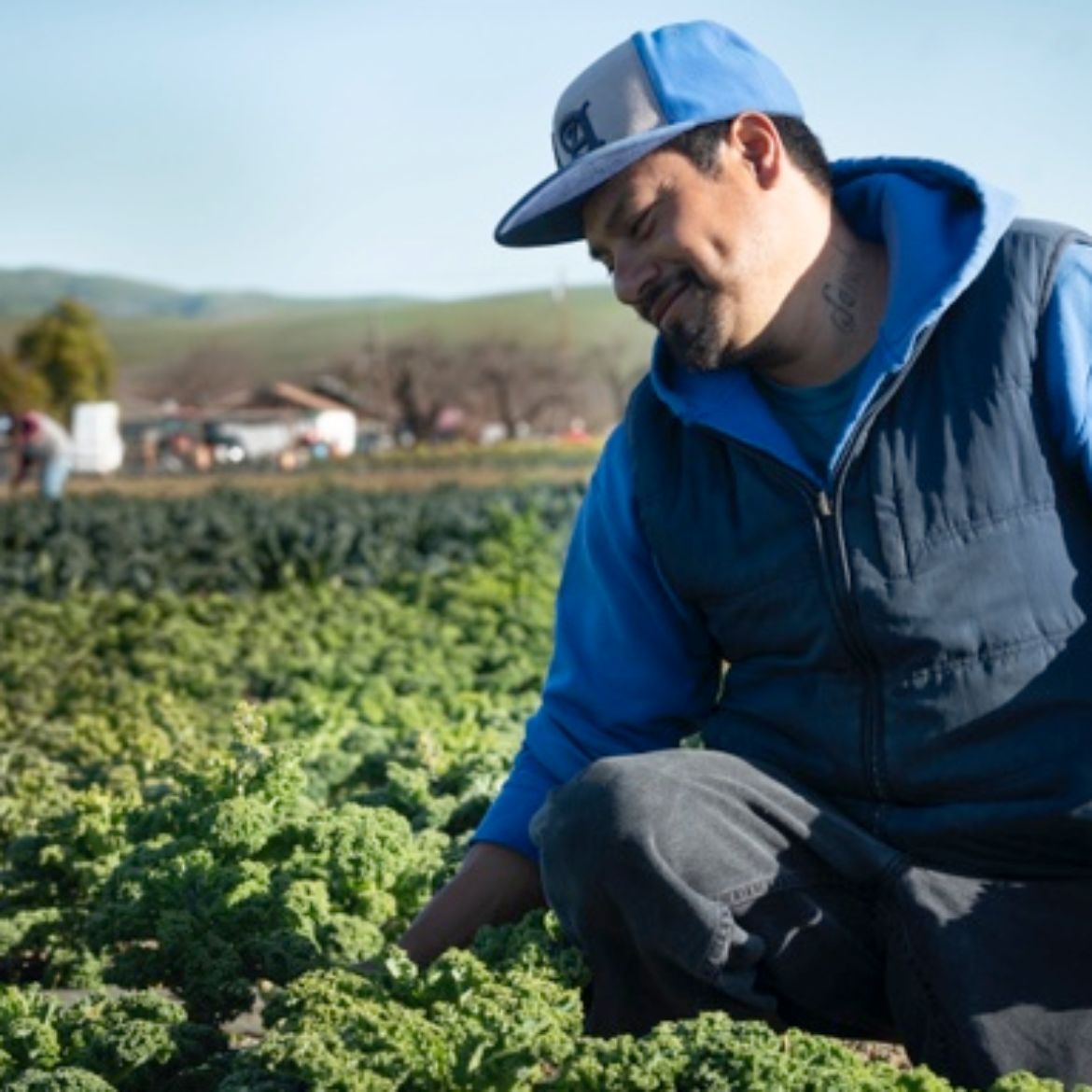
Building School Food Supply Chains Rooted in Community
January 11, 2024 | By Melissa Cipollone
Because of their sheer scale, school meal programs have an outsized impact on the nation’s food system. Strengthening relationships between schools and community-based food system stakeholders can build more nourishing, sustainable, and equitable school meal programs.
Approximately 100,000 schools across the U.S. serve lunch to 30 million students every school day. For comparison, there are less than 50,000 McDonald’s franchises around the world. The school food industry is—quite literally—huge.
Because of its sheer scale, school meal programs have an outsized impact on the nation’s food system. Shifting the way a district sources its food could improve the quality of students’ meals and, in turn, students’ health and well-being. It could bolster the local economy. It could introduce kids to new, culturally relevant foods. It could strengthen relationships between community members. It could reduce carbon emissions connected to shipping and packaging. It could protect clean air and water by supporting farms committed to environmentally sustainable practices. And so much more.
“Public institutions collectively spend about $120 billion each year to procure their food. … If institutions adopt a values-based purchasing model, in which they change their procurement practices to reflect the values of the communities they serve, they can redirect billions of dollars toward building a more ethical food system.”
—Procuring Food Justice, Food Chain Workers Alliance & HEAL Food Alliance
The Power of Partnership
Chef Ann Foundation’s grant program Partnerships for Local Agriculture & Nutrition Transformation in Schools (PLANTS) is the result of a cooperative agreement with USDA’s Food and Nutrition Service’s Healthy Meals Incentives Initiative, which is focused on improving the nutritional quality of school meals through food systems transformation. PLANTS aims to achieve this by propelling community-powered systems change.
Central to this work is building and strengthening partnerships among schools, farms, food businesses, students, parents, and other community stakeholders who are involved with school meal programs. If a school district sources as much of its food as possible from local, sustainable farms and businesses specializing in producing whole and unprocessed foods, such as fresh tomatoes, or minimally processed foods, such as tomato sauce, it could have a transformative effect on its community.


The Power of Partnership
Chef Ann Foundation’s grant program Partnerships for Local Agriculture & Nutrition Transformation in Schools (PLANTS) is the result of a cooperative agreement with USDA’s Food and Nutrition Service’s Healthy Meals Incentives Initiative, which is focused on improving the nutritional quality of school meals through food systems transformation. PLANTS aims to achieve this by propelling community-powered systems change.
Central to this work is building and strengthening partnerships among schools, farms, food businesses, students, parents, and other community stakeholders who are involved with school meal programs. If a school district sources as much of its food as possible from local, sustainable farms and businesses specializing in producing whole and unprocessed foods, such as fresh tomatoes, or minimally processed foods, such as tomato sauce, it could have a transformative effect on its community.
PLANTS focuses on strengthening local partnerships because collaboration is a necessary first step to improve the conventional supply chain. To create school food supply chains rooted in shared community values, it’s necessary to level the playing field so that all actors in the local school food system hold influence and decision-making power.
Schools are encouraged to purchase nutrient-dense foods that meet USDA meal pattern requirements while also considering the values of students, parents, and other community stakeholders. By collaborating with farmers, ranchers, and local food businesses who have been historically underserved, schools can contribute to a more equitable distribution of food markets within their communities. (Photo credit: Jacque Rupp)

Expanding Scratch Cooking
In addition to fostering partnership, another core component of PLANTS is expanding scratch cooking in schools. Being able to prepare meals from scratch is typically a prerequisite for schools to be able to source food from local farms.
Schools need specialized equipment, skilled staff, and production processes in place to be able to turn the fresh, whole ingredients they purchase from local producers into scratch-cooked meals that meet USDA school meal pattern requirements.

Expanding Scratch Cooking
In addition to fostering partnership, another core component of PLANTS is expanding scratch cooking in schools. Being able to prepare meals from scratch is typically a prerequisite for schools to be able to source food from local farms.
Schools need specialized equipment, skilled staff, and production processes in place to be able to turn the fresh, whole ingredients they purchase from local producers into scratch-cooked meals that meet USDA school meal pattern requirements.
Expanding scratch cooking in schools can take place gradually over time—for example, a school district might start by serving one scratch-cooked meal a week and continue growing its scratch cooking capacity over several years as it acquires more equipment and as its foodservice staff develop additional cooking skills. Chef Ann Foundation’s The Lunch Box offers a collection of free resources that can help schools expand scratch cooking.
Cultivating Resilience
School food supply chains rooted in strong community relationships are also more resilient to unexpected disruptions or emergencies. When something goes wrong, community stakeholders who are well connected can nimbly work together to solve problems more efficiently, more creatively, and with more collective resources.
This was exemplified at the height of the COVID-19 pandemic when schools across the country with established relationships with local farmers and other local food businesses were able to respond to rapidly evolving safety precautions and conventional supply chain disruptions to ensure kids had uninterrupted access to school meals. Plus, these established community networks provided a lifeline to many local food producers and food businesses during a time of financial uncertainty, as restaurants closed and farmers lost once-reliable markets.


Cultivating Resilience
School food supply chains rooted in strong community relationships are also more resilient to unexpected disruptions or emergencies. When something goes wrong, community stakeholders who are well connected can nimbly work together to solve problems more efficiently, more creatively, and with more collective resources.
This was exemplified at the height of the COVID-19 pandemic when schools across the country with established relationships with local farmers and other local food businesses were able to respond to rapidly evolving safety precautions and conventional supply chain disruptions to ensure kids had uninterrupted access to school meals. Plus, these established community networks provided a lifeline to many local food producers and food businesses during a time of financial uncertainty, as restaurants closed and farmers lost once-reliable markets.
“Communities with existing farm to school initiatives and multi-agency collaboratives were able to quickly pivot to provide urgently needed food access while re-investing local, philanthropic, and federal dollars into a local food economy reeling from pandemic disruptions. It is precisely because of community-scale networks and ongoing partnerships (rather than large scale or consolidated efforts) that initiatives … were able to provide hundreds of thousands of pounds of locally produced, fresh, and healthful foods to community members impacted by COVID-19 and the associated economic crisis.”
— Local Food Systems Response to COVID: Building Better Beyond, Farm to Institution New England, National Farm to School Network, University of Kentucky
Take Action
If transforming school food supply chains to enhance K-12 meal quality and strengthen community partnerships is your passion, we invite you to consider submitting a PLANTS grant proposal. Additionally, we urge you to disseminate this amazing opportunity within your network. Learn more and apply at plantsgrant.org.
PLANTS is funded by the USDA Food & Nutrition Service’s Healthy Meals Incentives Initiative and is administered by Chef Ann Foundation in partnership with Kitchen Sync Strategies Collaborative, Gretchen Swanson Center for Nutrition, and National Farm to School Network.







